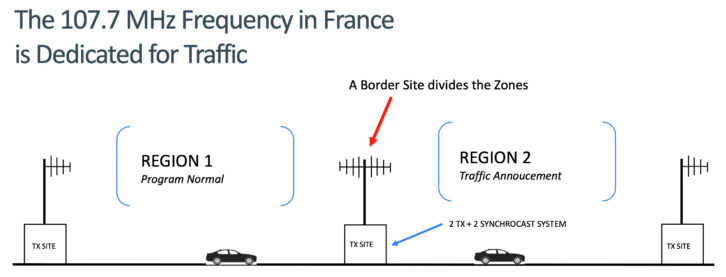The author is chief technology officer of GeoBroadcast Solutions.
The prospect of geotargeting radio transmissions to better serve the public has seemingly been a pipedream for OTA broadcasters, as they’ve watched their television and mobile competitors improve their revenues through technology that seemed beyond reach. And, although radio still maintains the highest audiences for sources of entertainment, news and information, the elusive goal of localizing its content has been a hurdle it can’t leap until the FCC allows separate single-frequency network content.

Think of the highest-powered, largest radio stations in the country and consider their reach and popularity. Now consider how better served their millions of listeners would be — through the very same call letters on the dial — if they could receive a localized early warning weather alert or, simply, a news update or traffic report that was more specific to their region than it is today.
Now recognize the competitive disadvantage radio has to ATSC 3.0 TV or mobile apps because its advertising is too cost-prohibitive for small business or regional political advertisers who only need to reach a limited audience in the broadcaster’s signal.
On March 13, GeoBroadcast Solutions requested from the FCC a minor rule change to allow radio broadcasters the ability to air geotargeted programming, including emergency alerts, news and advertising, on a voluntary basis through technology we developed called ZoneCasting.
[FCC Seeks Comment on Geo-Targeting for Radio Stations]
For radio, localization is a sort of holy grail. With technological abilities to improve signal strength and reach, the only impediment is providing a personalized experience for each listener at every exit on the airwave highway. That elusive “last mile” has just recently been a boon to TV, internet and mobile devices, and it should now be granted to radio.
TESTED TECHNOLOGY
GeoBroadcast began in 2011 to explore and design an FM single-frequency network that would create geotargeted coverage areas, or zones, that could deliver separate audio content to those zones.
As an outgrowth of this research we discovered new design parameters and processes that could use the same technology to help stations improve coverage in low signal areas. Since the main program audio would be unchanged, and therefore is fully compliant with all FCC rules, GeoBroadcast rolled out MaxxCasting, which further allows the Radio Data System (RDS) screen to carry zoned data for targeted on-screen advertising.
Put simply, MaxxCasting is a system of FM on-channel boosters, otherwise known as a single-frequency network deployed similar to cellular technology, with transmitters fully synchronized to boost the signal from the main transmitter with seamless transitions from the main to the booster nodes. Since the signal level is vastly improved in otherwise spotty areas, the host station enjoys higher listening — and greater recovery of Nielsen PPM decoding.
If we take a MaxxCasting system and add some additional equipment, we can actually geotarget programming from the station — this is ZoneCasting. The process is made by arranging transmitters in a cluster to allow programming in the zoned area break away from the main signal and transmit geotargeted content.
One of MaxxCasting’s recent deployments was at Cumulus’s WXLO(FM) just outside of the Boston market. Until implementing the technology the station didn’t get a listenable signal into central Boston. Now in place, the signal added about 1 million potential listeners to the WXLO signal and changed the profile of the station virtually overnight. With the installation of its new highly-directional antennas WXLO has added geotargeted RDS information, which will change what the listener sees on his screen. This adds a new revenue source to the WXLO signal and poises it for using ZoneCasting if the FCC agrees with the petition.
We estimate that geotargeting will be active about 5% of the overall time, and will be primarily used during commercials, local news, weather or emergency alerts. Stations can also operate in multiple zones and generate local revenue in each one. When ZoneCasting is not active, the boosters often revert to MaxxCasting, for improved coverage.
As for the listener experience, tests have shown that the transition areas do not cause interference and there is no noticeable change in audio. Transitions are not long enough to be noticeable. For the average listener the change-over would appear as if the station would be switching to a network news feed or different programming.
For station groups and owners, the costs of embracing this new technology would be elective. If the rule change request was accepted by the FCC, there would be no changes to the interference rules requested, and participation would be entirely voluntary.
PROOF OF CONCEPT IN FRANCE
We traveled to France in the summer of 2019. Its national highway system has been using a ZoneCasting-like system.

Station 107.7 is broadcast along the roadways by many different operators, with each operator required to bring local traffic and emergency information as needed to drivers. Its system uses over 1,100 transmitters to create zones every 8 to 10 kilometers on average. When not broadcasting localized information, the network provides music and news that may vary by region or operator. Sometimes it’s the same programming and sometimes it’s different.
What we learned from the models in France was that the ZoneCasting concept is feasible and that it can be successfully deployed. In France this system of entertainment and zoned information has been very successful.
DO LISTENERS CARE? DO ADVERTISERS?
Yes, and yes. In 2018 Edison Research found that 77% of listeners say they would pay more attention to ads on the radio if they were for local products or businesses, and 72% said they would actually listen more to their radio station if the commercials they heard were better targeted to their local area.

Generations of radio listeners embrace their favorite stations but are used to filtering out the ads, traffic reports and news that do not pertain to them. A geotargeted broadcast would surprise and awaken their listening experience.
Advertisers have begun embracing geotargeting in television and mobile to localize their reach and are looking forward to using radio to reach specific communities. Stations with geotargeting capability would be able to offer lower-cost advertising opportunities to small businesses, restaurants, medical centers and even local political races.
BIA Advisory Services estimates the impact of zoned radio advertising could provide more than $750 million in needed added revenue to the industry. Its recent survey with Advertiser Perceptions found that more than 90% of local retailers and two-thirds of national advertisers are poised to put more money into FM radio when geotargeting becomes available.
PASSING ALL TESTS
The GeoBroadcast Solutions technical team has been involved in SFN design and deployment for many years. Our patented multiple node FM analog stereo and analog/ HD Radio SFN design has now been successfully deployed across the United States.
In order to obtain design parameters on what listeners will accept for interference, Geo contracted NPR Labs and Towson University for a subjective analog FM listening study (one of the largest ever) to determine objective target parameters Geo used both for Maxxcasting and ZoneCasting geotargeting research and development.
The results were instrumental in the now field-proven successful design for Maxxcasting, and we believe we can now leverage the Maxxcasting specifications to implement Zonecasting when approved by the FCC.
NEXT STEP: PUBLIC COMMENT
This is a forward-moving initiative that now requires industry and public support. Tell the NAB and FCC what you think. The commission is taking comments at www.fcc.gov/ecfs/filings (use proceeding RM-11854). Comments must be uploaded in a .doc or .pdf format.
Bill Hieatt oversees GBS technology operations including system architecture definition, network infrastructure design, single-frequency network, RF coverage/field measurements/model tuning, project management, intellectual property development, patent applications and field trials.







